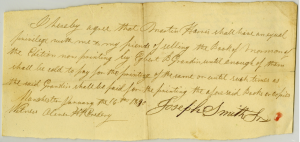COPYRIGHT 2026 SCRIPTURE CENTRAL FOUNDATION: A NON-PROFIT ORGANIZATION. ALL RIGHTS RESERVED. REGISTERED 501(C)(3). EIN: 39-2827600
Historical Context and Background of D&C 19

Video Overview
Brief Synopsis by Steven C. Harper
Martin Harris was “one of the most respected farmers in Wayne County,” a prosperous, property-owning Palmyran since 1808.1 In summer 1829 Martin and Joseph agreed to terms with a Palmyra printer named Egbert Grandin to publish the Book of Mormon. It was a controversial book and they wanted to print a large run of 5,000 copies.
Martin led the negotiations and planned to pay for the printing, but he balked when Grandin refused to begin work until he had security for the entire payment.2 They worked out an agreement in which Grandin would print and bind all 5,000 copies of the book for $3,000, with Martin putting up more than 150 acres of land as collateral. That’s when Martin “staggered in his confidence.”3 He would have to mortgage all the land he owned outright. The marvelous work halted for most of the summer.
Martin worried the no one would buy the books and he would lose his farm. “I want a commandment,” he told Joseph, “I must have a commandment.” So Joseph asked and the Lord gave a commandment, section 19.4 In a word, the commandment was “repent.” Frequent, intense repetition of “I command” and “repent” dominate this text. It offers astonishing autobiographical insight into the Savior’s Atonement. It begins in the voice of the Almighty Christ. First, he clarifies a mystery, or a common debate at the time about whether God’s punishment would last forever or not. Didn’t the word eternal obviously mean “never-ending,” proponents might argue? Not necessarily, the Lord answers. Consider that it can be a qualitative measure as well as a quantitative one. The acts of Christ’s suffering and being resurrected didn’t last forever, and yet they have eternal consequences. Punishment, perhaps, can be limited in duration and yet lasting in effect. Moreover, Christ says, eternal “is more express” than other words (D&C 19:7).
With that, the Savior begins to make his intended point powerfully. He repeatedly commands Martin to repent because Christ suffered exquisitely so that he could. This is the best autobiographical description of the Savior’s atoning suffering in the scriptures. It is wrenching, beautiful, and powerful. Compare section 18, for example, where the Savior speaks briefly and modestly in the third person voice to describe how he suffered the pain of all so that all might repent (D&C 18:10–13). It’s the same doctrine declared by the same Christ but in an entirely different voice and tone. Section 19 is adapted to Martin’s present predicament, which Christ knows how to address.
Throughout section 19 there is subtle allusion in which Christ compares himself to Martin implicitly. As Martin wrestles with whether he should keep his promises, and whether the sacrifice asked of him is too great, the Savior declares his character: he keeps promises. He made the infinite sacrifice. Where Martin is concerned with carnal security, the Savior shows contempt for covetousness. Where Martin is coveting his own property, the Lord compares it to the priceless testament of Jesus Christ, the “Book of Mormon, which contains the truth and word of God” (D&C 19:26).
This revelation reoriented Martin Harris. He grasped what the Lord was saying so expressly. He learned to let this commandment suffice and not ask again (D&C 19:32). He obeyed the Lord’s command to “not covet thine own property, but impart it freely to the printing” (D&C 19:26). He mortgaged his farm on August 25, paying Grandin in full.5 Once the paperwork was finished, Grandin’s employees began printing. The marvelous work was back on track.
1. Pomeroy Tucker, Origin, Rise, and Progress of Mormonism: Biography of Its Founders and History of Its Church (New York: D. Appleton, 1867), 41, 50.
2. John H. Gilbert, Memorandum, September 8, 1892, photocopy, MS 9223, Church History Library, Salt Lake City. “Mormon Leaders at Their Mecca,” New York Herald, June 25, 1893, 12.
3. Tucker, Origin, Rise, and Progress of Mormonism, 51.
4. Joseph Knight, Sr. Reminiscences, no date. MS 3470, Church History Library, Salt Lake City.
5. Martin Harris, Mortgage to Egbert B. Grandin, August 25, 1829, Mortgages, Liber 3, 325, Wayne County Clerk’s Office, Lyons, New York.
Additional Context by Casey Paul Griffiths
From Doctrine and Covenants Minute
We do not know the exact date that section 19 was given. Historians from the Joseph Smith Papers project have dated the revelation to the summer of 1829, though it is possible it came a few months later, in early 1830. As Joseph Smith and his friends prepared the Book of Mormon manuscript for printing, Martin Harris, who had agreed to provide the majority of the project’s funding, began to express doubts about the amount of debt he was entering into. Martin expected to pay off the debt through the revenue generated by selling copies of the Book of Mormon.
Egbert B. Grandin, the printer Joseph and Martin were negotiating with, had asked for $3,000 to carry out the unusually large order of 5,000 copies of the Book of Mormon. Because of the risky nature of the venture, Grandin told Joseph and Martin that he would not even buy the type or start the printing until one of them agreed to “promise to insure the payment for the printing.” To begin the printing, Martin would have to give up nearly all of the property he owned. Not knowing if he would ever be able to recoup the investment, Martin experienced an intense trial of faith. It is likely under these circumstances that he petitioned Joseph Smith to inquire of the Lord, and the following revelation was received on Martin’s behalf.
“Historical Introduction,” Revelation, circa Summer 1829 [D&C 19]